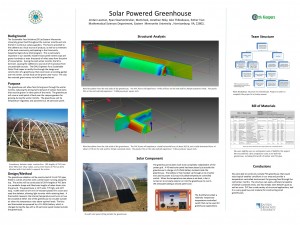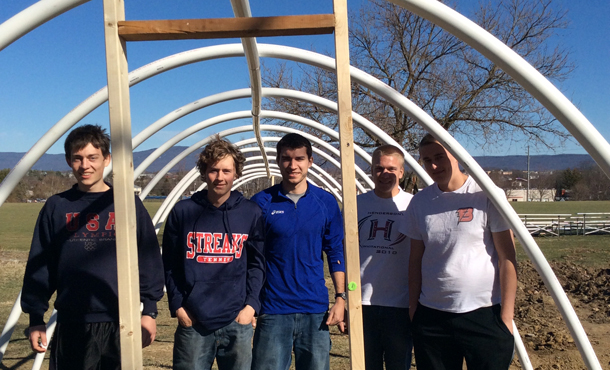The newest structure on Eastern Mennonite University’s campus cost just $600 to build and was completed by six students in less than eight hours. This fall it will extend the growing season for tomatoes, and next winter it will provide the cafeteria with leafy greens.
A poster describing the project – a solar-powered greenhouse – also won second place in the first- and second-year Engineering Design Team Division at a regional conference of the American Society for Engineering Education, held in Georgia at Mercer University from March 30 to April 1, 2014.
Three members of EMU’s chapter of Engineers for a Sustainable World (ESW) (the first chapter in Virginia) traveled to the conference along with faculty advisor Esther Tian, assistant professor of engineering.

“Our poster was unique because it described something tangible that we had built,” says ESW club president Jordan Leaman. “Many of the other projects were research-based and not very practical.”
Earlier this winter, the seed of the greenhouse project germinated in a brainstorming session between first-year roommates Leaman and peacebuilding and development major Jonathan Nisly. Building a greenhouse for EMU’s Sustainable Food Initiative (SFI) was Nisly’s idea. Funding for the project came from Earthkeepers.
“A lot of people build these structures with 20-foot lengths of PVC pipe, adding as many hoops as you want for the length of the greenhouse,” says Leaman.
Two weeks prior to the conference, six ESW club members assembled the 12 x 50-foot skeleton of the greenhouse, sealing it with a 6 mil plastic sheet the following week. The interior was 20 degrees warmer than outside temperatures the next day.
To complete the project, the club will apply for a grant from Engineers for a Sustainable World for fans and supplemental solar heat to further extend the growing season through the winter months.
The aerodynamic shape of the curved tunnel helps with wind resistance. Without fittings on the pipes, the structure can bend and flex with high winds. (The students admit they called back to campus to confirm the greenhouse withstood the 50-mph gusts that blew through Harrisonburg while they were at the conference.)
That weekend, the students from EMU had the opportunity to mix with young engineers from other schools who presented a range of projects, and learned about humanitarian engineering projects sponsored by Mercer University.
“The conference was kind of a whirlwind of new ideas and information being thrown at us,” says Nisly.
A presentation on prosthetics design and testing – part of a Mercer project working with amputees in Vietnam – gave the students insights into practical applications of engineering principles, says Tian.
“Engineers working to promote environmental, economic and social sustainability is very important to me,” she says. One of Tian’s first initiatives after joining EMU’s math and pre-engineering faculty in the fall of 2013 was to start an ESW chapter. She is pleased that the club’s first project received regional recognition.
In the poster’s conclusion, the ESW students describe the greenhouse as “a valuable asset to the university, as well as an opportunity for the ESW club to put our skills to work. It is a project that can be used as a model for other academic institutions, and we hope its impact will reach beyond our campus.”
Pre-engineering students at EMU have successfully moved from a strong foundation in math, physics and engineering classes to excel in specialized engineering schools at universities such as Penn State, Virginia Tech, and the University of Virginia, says Tian.
